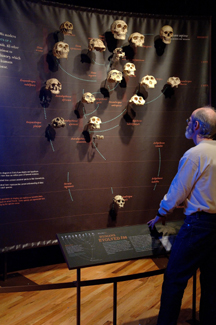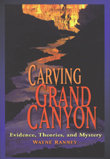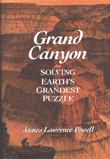Geotimes

Untitled Document

Geomedia
Geotimes.org offers
each month's book reviews, list of new books, book ordering information and new
maps.
Check out this month's On
the Web links, your connection to earth science friendly Web sites. The
popular Geomedia feature is now available by
topic.
Museums: Darwin’s life and work on exhibit
Books: Deciphering the Grand Canyon
Darwin’s
life and work on exhibit
 On Nov. 19,
2005, the life and work of Charles Darwin went on exhibit at the American Museum
of Natural History (AMNH) in New York City. The exhibit will stay in New York
until May 29, after which it will travel the world, making a stop at London’s
Natural History Museum in 2009 to celebrate the bicentennial of Darwin’s
birth. Meanwhile, visitors to New York — or to AMNH’s Web
site about the exhibit — can learn about the man who developed the theory
of evolution.
On Nov. 19,
2005, the life and work of Charles Darwin went on exhibit at the American Museum
of Natural History (AMNH) in New York City. The exhibit will stay in New York
until May 29, after which it will travel the world, making a stop at London’s
Natural History Museum in 2009 to celebrate the bicentennial of Darwin’s
birth. Meanwhile, visitors to New York — or to AMNH’s Web
site about the exhibit — can learn about the man who developed the theory
of evolution.
On the “wall of skulls,” a cladogram
depicts the evolutionary relationships between groups of primates, in the Darwin
exhibit at the American Museum of Natural History. Copyright of Denis Finnin,
AMNH.
A live giant tortoise greets visitors at the entrance to the exhibit, and along
the way, visitors can also marvel at a live iguana and horned frogs, as well as
a plethora of specimens from butterflies to birds that Darwin collected and brought
home from the Galápagos Islands, where he began to deeply consider the
patterns and distribution of life. His notebooks and magnifying glasses add fun
details, as visitors get to know Darwin and his work.
Once visitors wander further into the exhibit, they learn more about Darwin’s
personal life — for example, he was a fairly bad student, but followed his
father’s wishes and set out to be a doctor and then clergyman. Luckily for
science, however, an elite group of professors at Cambridge took young Darwin
under their wings and inspired him to become a naturalist. These professors sent
Darwin on the five-year trip around the world on the Beagle, where he began
thinking about the interconnectedness of all life on Earth, past and present.
Visitors tour through his discoveries and the questions that those discoveries
prompted Darwin to ask.
More than two decades passed after Darwin’s voyage before he decided to publish
his theory: He was struggling with moral and religious implications of his idea,
as well as trying to work out critical details of the theory — enough to
satisfy critics and avoid public ridicule. He finally published in the late 1850s,
after a contemporary, Alfred Russell Wallace, wrote and told Darwin he was going
to publish a theory of natural selection eerily similar to his. Darwin presented
and published his theory immediately.
The exhibit also delves into intense but easy-to-digest detail about the actual
science behind natural selection. It ends with a poignant discussion on Social
Darwinism (a sociological idea that purports that the powerful in human society
are innately better than the weak, and one with which Darwin would have hated
to be associated, visitors learn) and the ongoing current debate surrounding the
theory of evolution (see story, this issue).
Throughout the exhibit, several remarkably well-done videos emphasize the theory’s
and Darwin’s importance. Many prominent scientists in fields from bacteriology
to paleontology contributed to the videos, which are especially engaging.
The entire exhibit is evocative, perhaps because its curator Niles Eldredge is
a paleontologist who, alongside Stephen Jay Gould, developed the theory of punctuated
equilibria (the idea that the long process of evolution is “punctuated”
by quick bursts of change) in 1972, among many other important works. Over the
three years of planning to put together the exhibit, it took some maneuvering
to foot the $3 million bill. According to a report in the Nov. 22 Sydney Morning
Herald, AMNH could not find corporate sponsors for the exhibit because of
the ongoing heated evolution debate and instead relied on private donations. The
article said that the museum will also have to depend more heavily on profits
from the sale of tickets and Darwin-related merchandise.
Attending the exhibit requires a special time-stamped entrance ticket, in addition
to an admission ticket to the museum, bringing the total cost to $21 for adults,
$16 for students over 12 and seniors, and $12 for kids aged 2 to 12. The price
of admission is well worth it.
But if you cannot attend the exhibit itself, you can still learn a lot about Darwin
by checking out the museum’s hefty Darwin Web site (www.amnh.org/exhibitions/darwin).
It allows visitors to walk through the exhibit and watch the videos, and offers
an educator’s guide and guides for parents, kids and the general public to
learn about evolution.
Megan Sever
Links:
"Victory
for evolution in Dover," Geotimes, February 2006
AMNH
Darwin Web site
Back to top
Book
review
 Carving
Grand Canyon: Evidence, Theories, and Mystery Carving
Grand Canyon: Evidence, Theories, and Mystery
by Wayne Ranney.
Grand Canyon Association, 2005.
ISBN 0 9382 1682 1.
Softcover, $14.95.
|
 Grand
Canyon: Solving Earth’s Grandest Puzzle Grand
Canyon: Solving Earth’s Grandest Puzzle
by James Lawrence Powell.
Pi Press, 2005.
ISBN 0 1314 7989 X.
Hardcover, $27.95. |
Deciphering the Grand Canyon
“The Grand Canyon was carved by the Colorado River.” That statement
is perhaps the only one about the Grand Canyon on which most geologists who
study the feature can agree with certainty.
The details behind that statement remain murky, despite a century and a half
of scientific work on the canyon and its evolution. Two new books about the
Grand Canyon and its history — both human and scientific — make clear
the complexity and inscrutability of this stunning geologic feature.
Both books, Carving Grand Canyon: Evidence, Theories, and Mystery and
Grand Canyon: Solving Earth’s Grandest Puzzle, were published in
2005, several years after a landmark conference took place in 2000 at the national
park. Before the meeting, geologists had yet to hammer out a unifying theory
of what ultimately formed the Grand Canyon, and the number of hypotheses had
multiplied to several tens of possible scenarios: among them, a very old canyon
(80 million years), a very young one (6 million years or less), or a river that
once flowed in the opposite direction.
But at the end of the conference, writes Wayne Ranney in his book, Carving
Grand Canyon, geologists could settle on that most simple statement, of
the river having carved the canyon, as ultimately the only reason for the existence
of the feature. Ranney, a river guide and geologist who teaches at Yavapai College
in Sedona, Ariz., writes that he is well accustomed to describing this grandest
of geological puzzles for laypeople visiting the Grand Canyon, as well as for
his students, and his book, published by the Grand Canyon Association, bears
that out.
For a first-time visit to the Grand Canyon, this relatively slim volume will
come in handy both before and after the trip. The illustrations are useful and
straightforward, as is the prose — if only sometimes in need of copy-editing
— and the cover flaps of the book contain a timeline of and elemental data
on the river and canyon. Ranney covers the history of the scientists both past
and modern and what they thought made the Grand Canyon, building up to an excellent
concluding chapter. In the end, he manages to fit the history of the canyon
onto two short pages at the end of the 150-page book.
Not so for James Lawrence Powell’s lengthy tome, Grand Canyon: Solving
Earth’s Grandest Puzzle. Powell, a former geology professor at Oberlin
College and now executive director of the National Physical Science Consortium,
has turned his fieldwork and writing skills to a twisting and turning tale of
the high-walled valley, which is sometimes more confusing and backtracking than
the river’s own path.
Powell attempts to tell Grand Canyon history and geology in the context of the
life and science of John Wesley Powell (who is no relation to the author). The
first half of this book is a paean to Powell, the one-armed, self-educated major
who eventually headed the U.S. Geological Survey. While the historic figure
is obviously worthy of the focus of a book on the canyon, the repeated use of
“self-educated,” “rudimentary formal education” and other
such descriptive phrases to describe Powell weigh down the storytelling in some
places.
Despite this and some other style issues, the author includes some juicy tidbits
beyond just the elder Powell’s adventures and political missteps. He lays
out possibly all of the original hypotheses put forth by the earliest scientists
to try to solve the puzzle, from the first white man to see the canyon, to the
multitude of “great men” who wrote about it in the early 1900s, and
some of the people who continue to explore it today. Powell lovingly describes
their lives, the history of biblical versus natural historic thought and of
course the Grand Canyon itself.
Solving Earth’s Grandest Puzzle also contains a few attention-grabbing
stories of more modern interpretations of the valley’s and river’s
deposits. And in the end, Powell attempts to boil down the work done at that
geology powwow in 2000 into a chapter, to find a “new theory” of the
formation of the Grand Canyon. His conclusion, however, is more geologically
complex, resting more on the uplift of the Colorado plateau as the progenitor
of the Grand Canyon than on the simple statement that the river that flows through
it carved it. Although parts of the book are very accessible, some of the geology
may prove to be difficult reading for a nongeoscientist. Those readers who are
geologists, and particularly those who are obsessed with the Grand Canyon, most
likely will enjoy this book.
Naomi Lubick
Back to top
Untitled Document

 Carving
Grand Canyon: Evidence, Theories, and Mystery
Carving
Grand Canyon: Evidence, Theories, and Mystery Grand
Canyon: Solving Earth’s Grandest Puzzle
Grand
Canyon: Solving Earth’s Grandest Puzzle
 On Nov. 19,
2005, the life and work of Charles Darwin went on exhibit at the American Museum
of Natural History (AMNH) in New York City. The exhibit will stay in New York
until May 29, after which it will travel the world, making a stop at London’s
Natural History Museum in 2009 to celebrate the bicentennial of Darwin’s
birth. Meanwhile, visitors to New York — or to AMNH’s Web
site about the exhibit — can learn about the man who developed the theory
of evolution.
On Nov. 19,
2005, the life and work of Charles Darwin went on exhibit at the American Museum
of Natural History (AMNH) in New York City. The exhibit will stay in New York
until May 29, after which it will travel the world, making a stop at London’s
Natural History Museum in 2009 to celebrate the bicentennial of Darwin’s
birth. Meanwhile, visitors to New York — or to AMNH’s Web
site about the exhibit — can learn about the man who developed the theory
of evolution.